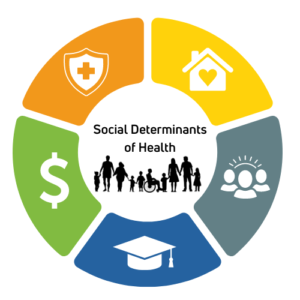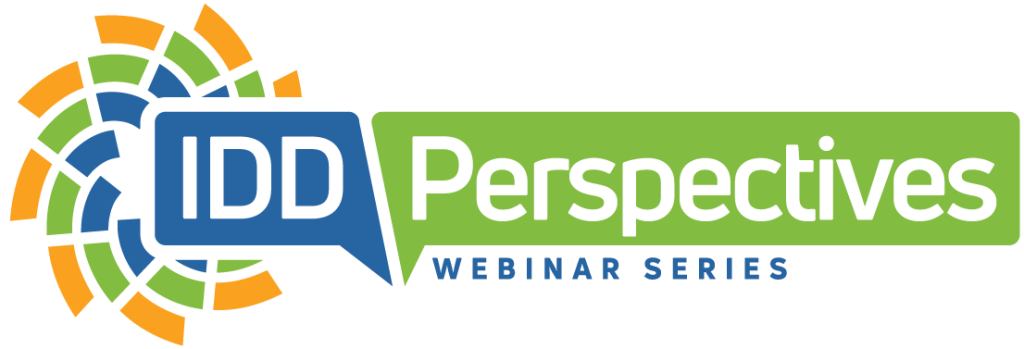
By Daleigh Tallent, MSN, RN, CDDN
Research continues to show people with intellectual and developmental disabilities (IDD) are at a high risk for health disparities, including a shorter life expectancy and earlier onset of age-related conditions 1, 2.
People with IDD are also more likely to have heart disease, osteoporosis, and high blood pressure compared to nondisabled people 2. However, these health disparities are not determined solely by the genetic makeup of a person with IDD. Nearly 80% of health outcomes are influenced by non-medical factors, with social determinants of health (SDOH) affecting as much as 50% 3. SDOH includes stable housing, food insecurity and access to nutritious foods, reliable transportation, health care access, safe neighborhoods, and many other socioeconomic aspects.
Why should we be concerned about SDOH?
If you’ve ever supported someone with IDD, you’ve likely encountered at least one of these SDOH challenges:
- Obtaining accessible, affordable housing in a safe neighborhood
- Addressing abuse, neglect, or exploitation of a person with IDD
- Acquiring job placement where the person is paid fairly, can work as many hours as they wish, and has reliable transportation to and from work
- Finding a school with early identification and intervention programs that effectively utilize individualized education plans (IEPs)
- Locating quality primary and specialty care in the local community
- Receiving health care from a provider who values the life of a person with IDD just as much as you do
These barriers can result in disparities that negatively impact a person’s functioning, social well-being, and overall health.
Health disparities and unmet SDOH can also lead to untimely death. This became starkly evident during the COVID-19 pandemic when people with IDD were often sent home from the emergency department when hospital resources were scarce or prevented from using their personal ventilators after being admitted 4.
Aren’t we already addressing SDOH?
Yes! Managing SDOH, such as housing, transportation, employment, and social integration, is not new to the field of IDD; it has been a core concept of IDD supports and services for over 40 years and resulted in increased life expectancy 5.
But! People with IDD and their supporters may have little to no control over systemic issues like inflation, infrastructure, and policies that impact socioeconomic status. They also face barriers within their very own communities including disability bias, diagnostic overshadowing, ableism, stigma, and discrimination. Confronting these multilevel social challenges requires time, money, and resources, which many IDD supporters do not have.
What can we do today to tackle unmet SDOH?
 IDD support teams do not have to wait on public health system changes to see improvement in health outcomes and happiness for those they serve; we can start addressing SDOH today on an individual basis by Asking, Screening, and Advocating.
IDD support teams do not have to wait on public health system changes to see improvement in health outcomes and happiness for those they serve; we can start addressing SDOH today on an individual basis by Asking, Screening, and Advocating.
Ask
Meet with the person and ask them about their life, ambitions, and social needs. What’s important to them? What is preventing them from achieving their personal goals? Asking about SDOH often uncovers past or current trauma. It’s important for supporters to understand this and be able to respond appropriately.
Screen
Adopt a routine screening process for the identification of any SDOH barriers. Completing a social needs screening is generally not required by healthcare providers, so if you’re not screening in-house, social risks may be going unnoticed. SDOH screenings do not have to be completed by clinicians and should be done at regular intervals to identify any trends.
There are several free screening tools that already exist including the Protocol for Responding to and Assessing Patients’ Assets, Risks and Experiences (PRAPARE) and the American Academy of Family Physicians (AAFP) Social Needs Screening Tool 6,7. IntellectAbility has created the first screening tool specifically for people with IDD, which can be downloaded here.
Advocate
Connect the person with community-based organizations and resources. The website findhelp.org (formerly known as Aunt Bertha) helps people easily locate and access social services in their local area 8. Develop a person-centered plan for addressing immediate, short-term, and long-term SDOH concerns. Provide ongoing support and encouragement to the person and their support team.
Due to the intimate nature of this field, IDD supports and services are well-positioned to identify unmet SDOH for our population. Focused efforts have increased longevity for people with IDD, but there’s still work to be done to minimize dangerous health disparities and inequities. Tools and resources are available today to help you create and implement steps to address SDOH. Just by asking, screening, and advocating, you can improve health outcomes and happiness for those you support.
Sources
- https://ncd.gov/publications/2022/health-equity-framework
- https://www.c-q-l.org/wp-content/uploads/2021/07/CQL-Research-2020-SDOH-outcomes-ER-IDD-Friedman.pdf
- https://aspe.hhs.gov/sites/default/files/documents/e2b650cd64cf84aae8ff0fae7474af82/SDOH-Evidence-Review.pdf
- https://www.ncd.gov/report/an-extra/
- https://behavioralhealthnews.org/using-social-determinants-of-health-for-the-field-of-intellectual-and-developmental-disabilities/
- https://prapare.org/the-prapare-screening-tool/
- https://www.aafp.org/dam/AAFP/documents/patient_care/everyone_project/hops19-physician-form-sdoh.pdf
- https://www.findhelp.org/




